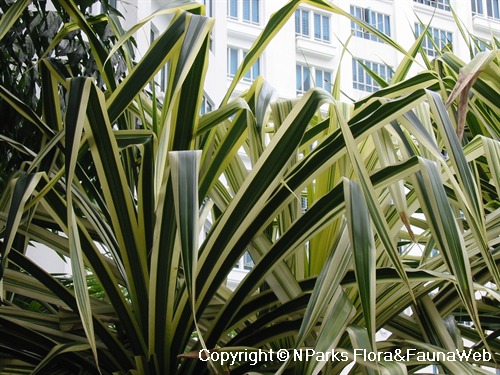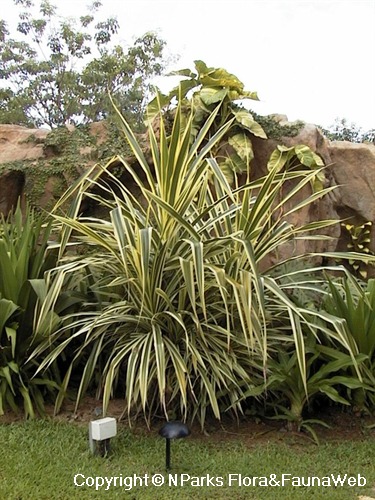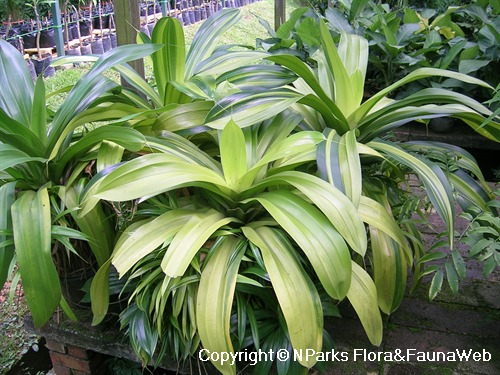
Name
Classifications and Characteristics
| Plant Division | Angiosperms (Flowering Seed Plants) (Monocotyledon) |
|---|---|
| Plant Growth Form | Shrub, Tree (Small (6m-15m)) |
| Lifespan (in Singapore) | Perennial |
| Mode of Nutrition | Autotrophic |
| Maximum Height | 4 m to 14 m |
Biogeography
| Preferred Climate Zone | Tropical |
|---|
Description and Ethnobotany
| Growth Form | It is a large, branching woody shrub or a small tree, up to 14 m tall. |
|---|---|
| Trunk | Its trunk is covered with sharp conical prickles. |
| Roots | It develops many prop and stilt roots from the bottom of the trunk or the side branches. |
| Foliage | Its long, linear leaves are about 4-8 cm wide and 80-180 cm long, with numerous spines along the edges and the underside of the midrib. The leaves are pleated, having a 'V' cross-section, and are spirally arranged in clusters at the tips of the branches. Normally, the leaves would be green in colour, however this cultivar has variegated leaves, with yellow or yellowish-white streaks running along the edges of the leaves, giving the plant a golden look. |
| Flowers | This species is dioecious, bearing male and female flowers on separate plants. The male flowers are small, white and fragrant, borne on a raceme which is subtended by a large, white bract. The female flowers are borne on a globose to subglobose flowering head. |
| Fruit | Its oval-shaped fruit is a multiple fruit which resembles a pineapple, about 4-20 cm wide and 8-30 cm long. It ripens from green to orange. Each individual segment (or fruitlet), is a wedge-shaped drupe (sometimes also known as 'key') that is fibrous and buoyant. |
| Cultivation | It can be propagated by seed or rooted stem cuttings. |
| Etymology | Latin Pandanus, from the Malayan name 'pandang' which refers to the screw pine. Latin tectorius, referring to rooftops or growing on rooftops or tiles, a reference to which is unknown. |
| Ethnobotanical Uses | Edible Plant Parts : Edible Fruits Food (Fruit or Vegetable): Cultivated varieties that have lower amounts of calcium oxalate crystals in the fruits are selected for consumption. The fruits are eaten raw or cooked. Medicinal: The young leaves are used to treat boils and other ailments in folk medicine. Timber & Products: The trunks are used to build houses, ladders, hard pillows, vases, fish traps, and is also a source of glue for canoes. They can also be used as firewood, dyes and other handicraft. Others: The leaves are used as roof and wall thatches. They are also woven to make various handicraft items such as baskets, bags, mats, fans, and pillows. |
Landscaping Features
| Landscaping | It is suitable for growing in large parks and gardens and also along roadsides for its attractive variegated leaves, orange fruits and fragrant flowers. The prop roots and fountain-form from the leaves also add variation to the landscape. It is also a highly versatile plant, being able to grow in dry soils as well as waterlogged areas. It is also resistant to salt sprays and saline soils. |
|---|---|
| Desirable Plant Features | Ornamental Foliage, Ornamental Fruits, Fragrant (Flowers) |
| Landscape Uses | Coastal, General, Suitable for Roadsides, Parks & Gardens, Beachfront / Shoreline, Riverine, Pond / Lake / River, Marsh / Bog, Focal Plant |
| Thematic Landscaping | Golden Garden, Naturalistic Garden, Water Garden, Marsh Garden |
Fauna, Pollination and Dispersal
| Seed or Spore Dispersal | Abiotic |
|---|
Plant Care and Propagation
| Light Preference | Semi-Shade, Full Sun |
|---|---|
| Water Preference | Little Water, Lots of Water, Moderate Water |
| Plant Growth Rate | Moderate |
| Rootzone Tolerance | Drought Tolerant, Moist Soils, Waterlogged Soils, Saline Soils / Salt Spray, Fertile Loamy Soils, Easy to Grow |
| Transplanting Tolerance | Good |
| Maintenance Requirements | Moderate |
| Propagation Method | Seed, Stem Cutting |
Foliar
| Foliage Retention | Evergreen |
|---|---|
| Mature Foliage Colour(s) | Green, Yellow / Golden |
| Foliar Type | Simple / Unifoliate |
| Foliar Arrangement Along Stem | Spiral |
| Foliar Attachment to Stem | Sessile |
| Foliar Shape(s) | Non-Palm Foliage (Linear) |
| Foliar Venation | Parallel |
| Foliar Margin | Serrate / Toothed |
| Leaf Area Index (LAI) for Green Plot Ratio | 3.5 (Shrub & Groundcover - Monocot) |
Floral (Angiosperm)
| Flower & Plant Sexuality | Unisexual Flowers , Dioecious |
| Flower Colour(s) | Cream / Off-White |
|---|
| Flower Grouping | Cluster / Inflorescence |
| Inflorescence Type | Raceme, Compound Head / Capitulum |
Fruit, Seed and Spore
| Mature Fruit Colour(s) | Orange |
|---|---|
| Fruit Classification | Multiple Fruit |
| Fruit Type | Fleshy Fruit , Non-Accessory Fruit |
Image Repository
Others
| Master ID | 1009 |
|---|---|
| Species ID | 2303 |
| Flora Disclaimer | The information in this website has been compiled from reliable sources, such as reference works on medicinal plants. It is not a substitute for medical advice or treatment and NParks does not purport to provide any medical advice. Readers should always consult his/her physician before using or consuming a plant for medicinal purposes. |



.jpg)

